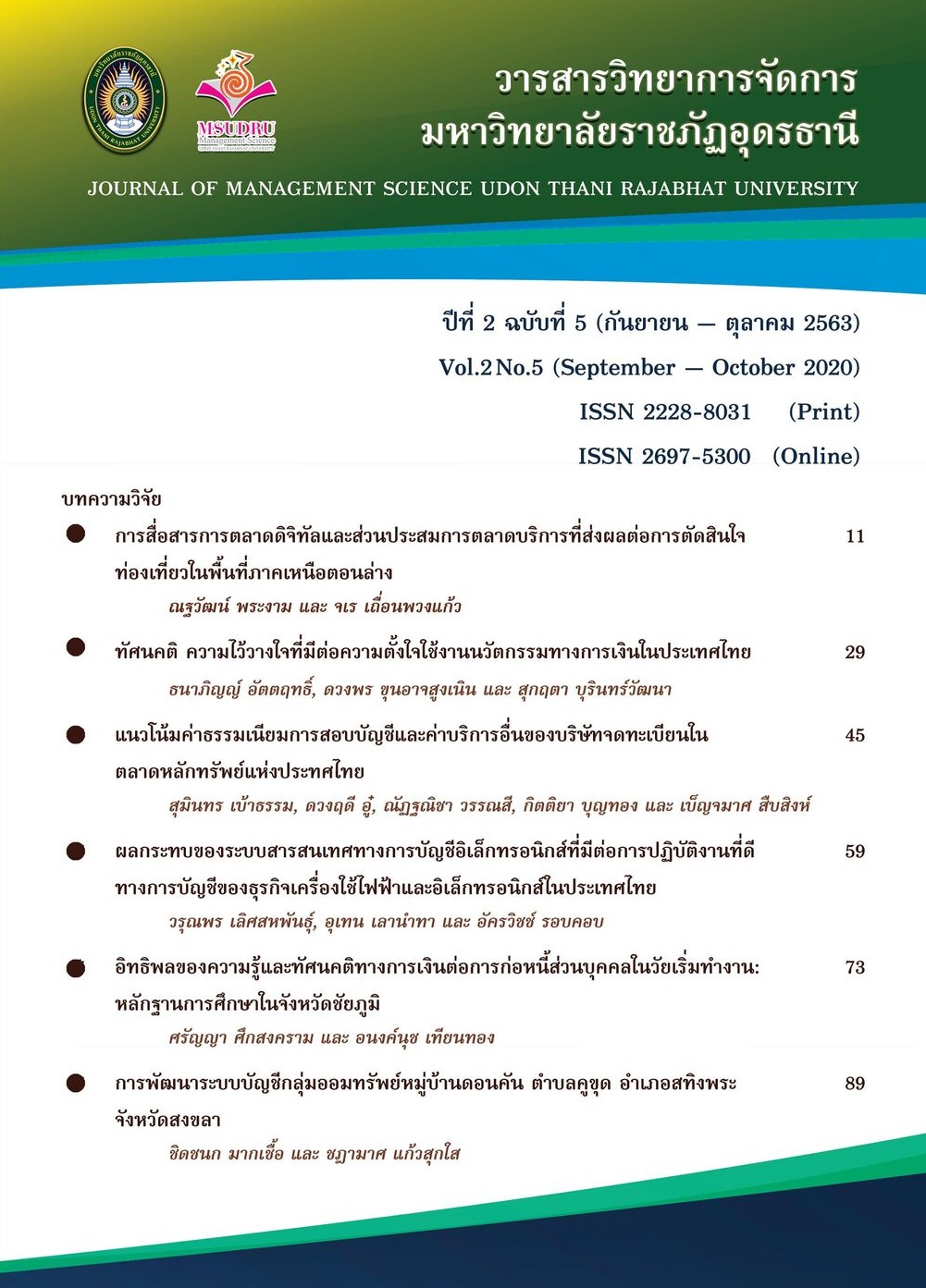อิทธิพลของความรู้และทัศนคติทางการเงินต่อการก่อหนี้ส่วนบุคคลในวัยเริ่มท างาน: หลักฐานการศึกษาในจังหวัดชัยภูมิ
Main Article Content
บทคัดย่อ
งานวิจัยนี้มีวัตถุประสงค์เพื่อศึกษาข้อมูลทั่วไปของกลุ่มผู้ก่อหนี้ในวัยเริ่มทำงานประกอบกับความรู้และทัศนคติทางการเงินต่อการก่อหนี้ส่วนบุคคล โดยกลุ่มตัวอย่างที่ใช้ศึกษา คือวัยทำงานที่มีช่วงอายุไม่เกิน 36 ปี ในจังหวัดชัยภูมิ เข้าถึงด้วยวิธีการสุ่มแบบเจาะจงรวมทั้งสิ้น 110 ตัวอย่าง การวิเคราะห์ข้อมูลประกอบไปด้วย 2 ส่วนคือ 1) วิเคราะห์ถึงลักษณะทั่วไป พฤติกรรมการเป็นหนี้ และอิทธิพลของความรู้และทัศนคติทางการเงินของกลุ่มตัวอย่างด้วยสถิติเชิงพรรณนา 2) การวิเคราะห์ผลกระทบของปัจจัยทางด้านความรู้และทัศนคติทางการเงินต่อการก่อหนี้ด้วยแบบจำลองถดถอยพหุคูณ ผลการศึกษาปรากฏว่า กลุ่มตัวอย่างส่วนใหญ่เป็นเพศหญิง อายุเฉลี่ย 31 ปี มีการศึกษาระดับปริญญาตรี ประกอบอาชีพเป็นพนักงานรัฐวิสาหกิจ มีรายได้เฉลี่ยอยู่ที่ 32,218 บาทต่อเดือน ส่วนพฤติกรรมการเป็นหนี้ของกลุ่มตัวอย่าง พบว่า กลุ่มตัวอย่างมีหนี้สินส่วนใหญ่เกี่ยวกับอสังหาริมทรัพย์ รองลงมาคือ หนี้สินเกี่ยวกับยานพาหนะและหนี้สินส่วนบุคคล มีความรู้และทัศนคติทางการเงินในระดับมาก โดยแบบจำลองวิเคราะห์การถดถอยพหุคูณ แสดงให้เห็นว่า ปัจจัยทางด้านอายุ การสมรส ความรู้ทางการเงิน และทัศนคติทางการเงิน มีอิทธิพลต่อการก่อหนี้ในวัยเริ่มทำงานอย่างมีนัยสำคัญทางสถิติ โดยปัจจัยสำคัญที่ส่งผลต่อการก่อหนี้คือ ความรู้ทางด้านการเงิน มีอิทธิพลสูงถึงร้อยละ 25.20
Article Details

อนุญาตภายใต้เงื่อนไข Creative Commons Attribution-NonCommercial-NoDerivatives 4.0 International License.
บทความที่ได้รับการตีพิมพ์เป็นลิขสิทธิ์ของคณะวิทยาการจัดการ มหาวิทยาลัยราชภัฏอุดรธานี
ข้อความที่ปรากฏในบทความแต่ละเรื่องในวารสารวิชาการเล่มนี้
ไม่ใช่ความคิดเห็นและความรับผิดชอบของผู้จัดทำ บรรณาธิการ กองบรรณาธิการ และคณะวิทยาการจัดการ มหาวิทยาลัยราชภัฏอุดรธานี ความรับผิดชอบด้านเนื้อหาและการตรวจร่างบทความแต่ละเรื่องเป็นความคิดเห็นของผู้เขียนบทความแต่ละท่าน
เอกสารอ้างอิง
ธนาคารแห่งประเทศไทย. (2559). ทักษะทางการเงิน (Financial Literacy). สืบค้นเมื่อวันที่ 15 กุมภาพันธ์ 2563, จาก https://www.bot.or.th/Thai/MonetaryPolicy/Northern/DocLib_SeminarSlide/160627_FAandFL_final.pdf.
นริศ สถาผลเดชา และ นันทพร ตั้งเจริญศิริ. (2561). เปิดมุมมองพฤติกรรมทางการเงินของคนไทย.สืบค้นเมื่อวันที่ 15 มกราคม 2562, จาก https://www.marketingoops.com/reports/behaviors/customer-insights-by-tmb-analytics/.
บริษัท ข้อมูลเครดิตแห่งชาติ จำกัด. (2561). อัตราการก่อหนี้จำแนกประเภทในแต่ละช่วงอายุ. สืบค้นเมื่อ 15 มกราคม 2562, จาก https://www.ncb.co.th/.
บริษัท ข้อมูลเครดิตแห่งชาติ จำกัด. (2561). อัตราการเติบโตของผู้ก่อหนี้รายใหม่. สืบค้นเมื่อวันที่ 15 มกราคม 2562, จาก https://www.ncb.co.th/.
สาวิณี สุริยันรัตกร. (2560). บทบาทของหนี้ครัวเรือนต่อการบริโภคในประเทศไทย. วารสารมหาวิทยาลัยราชภัฏมหาสารคาม, 11(1), 161-172.
สำนักงานเทศบาลเมืองชัยภูมิ. (2560). รายงานประมาณการเศรษฐกิจจังหวัดฉบับที่ 3. สืบค้นเมื่อ 7 มีนาคม 2563, จาก https://th.wikipedia.org/wiki/จังหวัดชัยภูมิ.
สำนักงานสภาพัฒนาเศรษฐกิจและสังคมแห่งชาติ. (2562). หนี้สินครัวเรือนและพฤติกรรมการก่อหนี้ของคนไทย. สืบค้นเมื่อวันที่ 15 มกราคม 2562, จาก https://www.isranews.org/thaireform/thaireform-documentary/82884-nesdb-82884.html.
Agnew, S., & Harrison, N. (2015). Financial Literacy and Student Attitudes to Debt: A Cross National Study Examining the Influence of Gender on Personal Finance Concepts. Journal of Retailing and Consumer Services, 25(July), 122-129.
Bahovec, V., Barbić, D., & Palić, I. (2015). Testing the Effects of Financial Literacy on Debt Behavior of Financial Consumers using Multivariate Analysis Methods. Croatian Operational Research Review, 6(2), 361-371.
Duesenberry, J. S. (1959). Income, Saving, and the Theory of Consumer Behavior. Cambridge: Harvard University.
Friedman, M. (1957). A theoretical framework for monetary analysis. Journal of Political Economy, 78(2), 193-238.
Froyen, R. T. (2013). Macroeconomics. (10th ed.). England: Pearson Education.
Ibrahim, M. E. & Alqaydi, F. R. (2013). Financial Literacy, Personal Financial Attitude, and Forms of Personal Debt among Residents of the UAE. International Journal of Economics and Finance, 5(7), 126-138.
Keynes, J. M. (1936). The General Theory of Employment, Interest and Money. New York and London: Harcourt, Brace Co.
Mandell, L., & Klein, S. L. (2009). The Impact of Financial Literacy Education on Subsequent Financial Behavior. Journal of Financial Counseling and Planning, 20(1), 15-24.
Marriott, P. (2007). An Analysis of First Experience Students’ Financial Awareness and Attitude to Debt in a Post-1992 UK University. Higher Education Quality Journal, 61(4), 498-519.
Modigliani, F., & Ando, A. (1963). The life cycle hypothesis of saving: Aggregate implications and tests. The American economic review, 53(1), 55-84.
Phenix, D. (1996). Social values. New Jersey: Prentice-Hall.
Schumacker, R. E., & Lomax, R. G. (1996). A beginner's guide to structural equation modeling. Lawrence Erlbaum.
Wealth Creation International. (2020). พฤติกรรมชวนจนของคนวัยทำงาน. สืบค้นเมื่อ 15 มกราคม 2562, จาก http://www.wci.co.th/article/Wealth/316/5พฤติกรรมชวนจนของคนวัยทำงาน.


